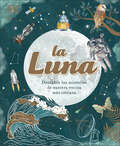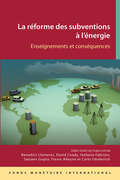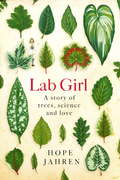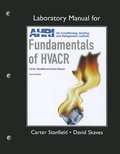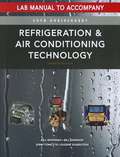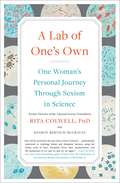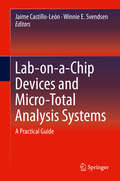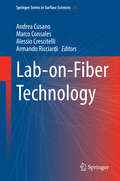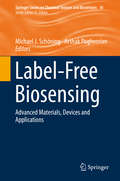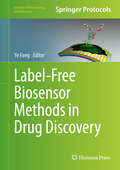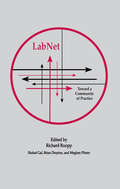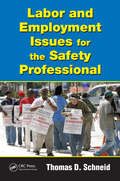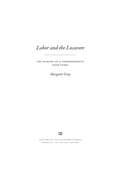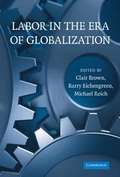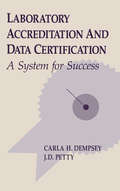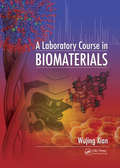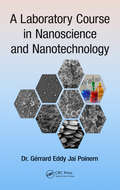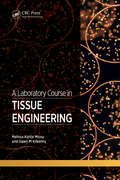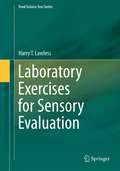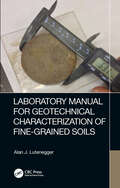- Table View
- List View
La luna (The Moon): Descubre los misterios de nuestra vecina más cercana
by Dr. Sanlyn Buxner- Las impresionantes ilustraciones hacen de este título un regalo perfecto.- Un libro repleto de información y curiosidades sobre la luna con imágenes sorprendentes.Un precioso libro ilustrado para aprender todo sobre la luna.Conoce el relieve de la luna, las fases lunares, la historia de las misiones de la NASA, el efecto de la luna en las mareas y en los animales nocturnos, los recientes descubrimientos científicos y mucho más.Con información detallada, fotografías, imágenes, ilustraciones y diagramas. Los niños pueden descubrir el pasado, el presente y el futuro de la luna.------------------------------------ A beautiful book focused entirely on La luna.- Covers the entire subject of the moon with incredible facts and images.A beautiful book focused entirely on the moon.Covers the entire subject of the moon – including its formation and geography, the lunar phases, a history of NASA&’s Apollo missions, its effect on Earth&’s tides and nocturnal animals, its place in our mythology, plenty of recent scientific discoveries, and more.
La réforme des subventions à l'énergie: Enseignements et conséquences
by International Monetary FundA report from the International Monetary Fund.
Lab Girl: A Story Of Trees, Science And Love
by Hope JahrenLab Girl is a book about work and about love, and the mountains that can be moved when those two things come together. It is told through Jahren's remarkable stories: about the discoveries she has made in her lab, as well as her struggle to get there; about her childhood playing in her father's laboratory; about how lab work became a sanctuary for both her heart and her hands; about Bill, the brilliant, wounded man who became her loyal colleague and best friend; about their field trips - sometimes authorised, sometimes very much not - that took them from the Midwest across the USA, to Norway and to Ireland, from the pale skies of North Pole to tropical Hawaii; and about her constant striving to do and be her best, and her unswerving dedication to her life's work.Visceral, intimate, gloriously candid and sometimes extremely funny, Jahren's descriptions of her work, her intense relationship with the plants, seeds and soil she studies, and her insights on nature enliven every page of this thrilling book. In Lab Girl, we see anew the complicated power of the natural world, and the power that can come from facing with bravery and conviction the challenge of discovering who you are.
Lab Manual for Fundamentals of HVACR (Second Edition)
by Carter Ahri Carter Stanfield David SkavesThis is a student supplement associated with: Fundamentals of HVACR, 2/e Carter Stanfield David Skaves AHRI ISBN: 0132859610
Lab Manual to Accompany Refrigeration and Air Conditioning Technology: Concepts, Procedures, and Troubleshooting Techniques
by William C. Whitman William M. Johnson John A. TomczykGive your students the hands-on practice and insights to support the concepts from this edition of the text with this proven lab manual. Each unit correlates with a unit in the text, and contains an overview, key terms, review test and Lab Exercises where applicable.
A Lab of One's Own: One Woman's Personal Journey Through Sexism in Science
by Rita Colwell Sharon Bertsch McGrayneA riveting memoir-manifesto from the first female director of the National Science Foundation about the entrenched sexism in science, the elaborate detours women have taken to bypass the problem, and how to fix the system. If you think sexism thrives only on Wall Street or in Hollywood, you haven&’t visited a lab, a science department, a research foundation, or a biotech firm. Rita Colwell is one of the top scientists in America: the groundbreaking microbiologist who discovered how cholera survives between epidemics and the former head of the National Science Foundation. But when she first applied for a graduate fellowship in bacteriology, she was told, &“We don&’t waste fellowships on women.&” A lack of support from some male superiors would lead her to change her area of study six times before completing her PhD. A Lab of One&’s Own documents all Colwell has seen and heard over her six decades in science, from sexual harassment in the lab to obscure systems blocking women from leading professional organizations or publishing their work. Along the way, she encounters other women pushing back against the status quo, including a group at MIT who revolt when they discover their labs are a fraction of the size of their male colleagues&’. Resistance gave female scientists special gifts: forced to change specialties so many times, they came to see things in a more interdisciplinary way, which turned out to be key to making new discoveries in the twentieth and twenty-first centuries. Colwell would also witness the advances that could be made when men and women worked together—often under her direction, such as when she headed a team that helped to uncover the source of the anthrax used in the 2001 letter attacks. A Lab of One&’s Own shares the sheer joy a scientist feels when moving toward a breakthrough, and the thrill of uncovering a whole new generation of female pioneers. But it is also the science book for the #MeToo era, offering an astute diagnosis of how to fix the problem of sexism in science—and a celebration of the women pushing back.
Lab-on-a-Chip Devices and Micro-Total Analysis Systems
by Jaime Castillo-León Winnie E. SvendsenThis book covers all the steps in order to fabricate a lab-on-a-chip device starting from the idea, the design, simulation, fabrication and final evaluation. Additionally, it includes basic theory on microfluidics essential to understand how fluids behave at such reduced scale. Examples of successful histories of lab-on-a-chip systems that made an impact in fields like biomedicine and life sciences are also provided. This book also: · Provides readers with a unique approach and toolset for lab-on-a-chip development in terms of materials, fabrication techniques, and components · Discusses novel materials and techniques, such as paper-based devices and synthesis of chemical compounds on-chip · Covers the four key aspects of development: basic theory, design, fabrication, and testing · Provides readers with a comprehensive list of the most important journals, blogs, forums, and conferences where microfluidics and lab-on-a-chip news, methods, techniques and challenges are presented and discussed, as well as a list of companies providing design and simulation support, components, and/or developing lab-on-a-chip and microfluidic devices.
Lab-on-Fiber Technology
by Andrea Cusano Marco Consales Alessio Crescitelli Armando RicciardiThis book focuses on a research field that is rapidly emerging as one of the most promising ones for the global optics and photonics community: the "lab-on-fiber" technology. Inspired by the well-established "lab on-a-chip" concept, this new technology essentially envisages novel and highly functionalized devices completely integrated into a single optical fiber for both communication and sensing applications. Based on the R&D experience of some of the world's leading authorities in the fields of optics, photonics, nanotechnology, and material science, this book provides a broad and accurate description of the main developments and achievements in the lab-on-fiber technology roadmap, also highlighting the new perspectives and challenges to be faced. This book is essential for scientists interested in the cutting-edge fiber optic technology, but also for graduate students.
Label-Free Biosensing: Advanced Materials, Devices and Applications (Springer Series on Chemical Sensors and Biosensors #16)
by Michael J. Schöning Arshak PoghossianThis volume summarizes the state-of-the-art technologies, key advances and future trends in the field of label-free biosensing. It provides detailed insights into the different types of solid-state, label-free biosensors, their underlying transducer principles, advanced materials utilized, device-fabrication techniques and various applications. The book offers graduate students, academic researchers, and industry professionals a comprehensive source of information on all facets of label-free biosensing and the future trends in this flourishing field. Highlights of the subjects covered include label-free biosensing with:· semiconductor field-effect devices such as nanomaterial-modified capacitive electrolyte-insulator-semiconductor structures, silicon nanowire transistors, III-nitride semiconductor devices and light-addressable potentiometric sensors· impedimetric biosensors using planar and 3D electrodes· nanocavity and solid-state nanopore devices · carbon nanotube and graphene/graphene oxide biosensors· electrochemical biosensors using molecularly imprinted polymers· biomimetic sensors based on acoustic signal transduction· enzyme logic systems and digital biosensors based on the biocomputing concept· heat-transfer as a novel transducer principle· ultrasensitive surface plasmon resonance biosensors · magnetic biosensors and magnetic imaging devices
Label-Free Biosensor Methods in Drug Discovery
by Ye FangThis volume explores label-free biosensors, advantageous in part because this technology bypasses the need of labels, reporters, and cell engineering, all of which are common to labeled techniques but may introduce artifacts in assay results. Addressing several fundamental and practical aspects as to how to implement label-free methods in the drug discovery process, this book covers a wide range of topics, including binding kinetics determination, fragment screening, antibody epitope mapping, protein-protein interaction profiling and screening, receptor pathway deconvolution, drug pharmacology profiling and screening, target identification, drug toxicity assessment, and physical phenotype profiling and diagnostics based on various cellular processes such as cell adhesion, migration, invasion, infection, and inflammation. As part of the Methods in Pharmacology and Toxicology series, chapters aim to provide key detail and implementation advice to aid with progress in the lab. Practical and thorough, Label-Free Biosensor Methods in Drug Discovery provides a new avenue for rapid access to a focused collection of highly regarded contributions in the field.
Label-Free Super-Resolution Microscopy (Biological and Medical Physics, Biomedical Engineering)
by Vasily AstratovThis book presents the advances in super-resolution microscopy in physics and biomedical optics for nanoscale imaging. In the last decade, super-resolved fluorescence imaging has opened new horizons in improving the resolution of optical microscopes far beyond the classical diffraction limit, leading to the Nobel Prize in Chemistry in 2014. This book represents the first comprehensive review of a different type of super-resolved microscopy, which does not rely on using fluorescent markers. Such label-free super-resolution microscopy enables potentially even broader applications in life sciences and nanoscale imaging, but is much more challenging and it is based on different physical concepts and approaches. A unique feature of this book is that it combines insights into mechanisms of label-free super-resolution with a vast range of applications from fast imaging of living cells to inorganic nanostructures. This book can be used by researchers in biological and medical physics. Due to its logically organizational structure, it can be also used as a teaching tool in graduate and upper-division undergraduate-level courses devoted to super-resolved microscopy, nanoscale imaging, microscopy instrumentation, and biomedical imaging.
Labnet: Toward A Community of Practice (Technology and Education Series)
by Richard Ruopp Shahaf Gal Brian Drayton Meghan PfisterConnected by a computer telecommunications network, ninth-graders from eight high schools scattered thousands of miles across Alaska work together, building a robot submarine to gather samples from the floor of Prince William Sound. This is high school science as some teachers and educational reformers today envision it -- centered on student projects that encourage learning by doing...supported by modern technology...enriched by collaboration among students and teachers, both face to face and far apart. This example is drawn from LabNet, a three-year effort funded by the National Science Foundation. The project was conducted by Technical Education Research Centers (TERC), a nonprofit educational organization dedicated to improving mathematics and science education. Eventually reaching 562 teachers in 37 states, Puerto Rico, and American Samoa, LabNet had a direct impact on their classroom practice. In a follow-up evaluation, the majority said they had assigned their students more projects and had used LabNet's telecommunications network to exchange project ideas with other teachers. This book is the story of LabNet as told by its editors, with 14 additional essays on science projects -- both theoretical and practical -- by LabNet teachers and TERC staff.
Labor and Employment Issues for the Safety Professional (Occupational Safety & Health Guide Series)
by Thomas D. SchneidAn examination of the safety laws and regulations, particularly in the areas of labor and employment, this book provides a working knowledge of the impacts, requirements, and implications of safety professionals' actions and inactions as related to state and federal laws. It presents information on an issue-by-issue basis and delineates the basics of the issue; identifies the applicable law or regulation; and presents possible solutions to achieve and maintain compliance while achieving the safety objective. The book covers conflicts between laws and regulations and includes case law and reference points.
Labor and the Locavore
by Margaret GrayIn the blizzard of attention around the virtues of local food production, food writers and activists place environmental protection, animal welfare, and saving small farms at the forefront of their attention. Yet amid this turn to wholesome and responsible food choices, the lives and working conditions of farmworkers are often an afterthought.Labor and the Locavore focuses on one of the most vibrant local food economies in the country, the Hudson Valley that supplies New York restaurants and farmers markets. Based on more than a decade's in-depth interviews with workers, farmers, and others, Gray's examination clearly shows how the currency of agrarian values serves to mask the labor concerns of an already hidden workforce. She also explores the historical roots of farmworkers' predicaments and examines the ethnic shift from Black to Latino workers. With an analysis that can be applied to local food concerns around the country, this book challenges the reader to consider how the mentality of the alternative food movements implies a comprehensive food ethic that addresses workers' concerns.
Labor in the Era of Globalization
by Clair Brown Barry Eichengreen Michael ReichThe third quarter of the twentieth century was a golden age for labor in the advanced industrial countries, characterized by rising incomes, relatively egalitarian wage structures, and reasonable levels of job security. The subsequent quarter-century has seen less positive performance along a number of these dimensions. This period has instead been marked by rapid globalization of economic activity that has brought increased insecurity to workers. The contributors to this volume, prominent scholars from the United States, Europe, and Japan, distinguish four explanations for this historic shift. These include 1) rapid development of new technologies; 2) global competition for both business and labor; 3) deregulation of industry with more reliance on markets; and 4) increased immigration of workers, especially unskilled workers, from developing countries. In addition to analyzing the causes of these trends, the contributors also investigate important consequences, ranging from changes in collective bargaining and employment relations to family formation decisions and incarceration policy.
Laboratory Accreditation and Data Certification: A System for Success
by Carla H. Dempsey Jimmie D. PettyThis book provides descriptions of current laboratory accreditation schemes and explains why these schemes fall short of assuring data purchasers that the data produced from accredited laboratories are always quality products. The book then presents a system for laboratory accreditation in conjunction with data certification that assures data purchasers their data are useful for the purposes for which they are intended. Simple quality assurance and quality control techniques, in addition to concepts of total quality management, are described and then applied to the environmental laboratory industry. This "System For Success" was developed from real problems and real solutions within the industry and represents an integration of proven techniques that offer a better way to ensure quality laboratory data is obtained. Laboratory Accreditation: A Workable Solution is a must for government officials, environmental professionals, independent environmental laboratories, hazardous waste disposal industries, chemical manufacturers, QA professionals, and testing laboratories.
A Laboratory Course in Biomaterials
by Wujing XianThe field of biomedical engineering has vastly expanded in the past two decades, as reflected in the increased number of bioengineering and biomaterials programs at universities. The growth of this area has outpaced the development of laboratory courses that allow students hands-on experience, since the barriers involved in creating multidisciplina
A Laboratory Course in Nanoscience and Nanotechnology
by Gerrard Eddy PoinernAlthough there are many theoretical nanotechnology and nanoscience textbooks available to students, there are relatively few practical laboratory-based books. Filling this need, A Laboratory Course in Nanoscience and Nanotechnology presents a hands-on approach to key synthesis techniques and processes currently used in nanotechnology and nanoscienc
A Laboratory Course in Tissue Engineering
by Melissa Kurtis Micou Dawn KilkennyFilling the need for a lab textbook in this rapidly growing field, A Laboratory Course in Tissue Engineering helps students develop hands-on experience. The book contains fifteen standalone experiments based on both classic tissue-engineering approaches and recent advances in the field. Experiments encompass a set of widely applicable techniques: c
Laboratory Design, Construction, and Renovation: Participants, Process, and Product
by Committee on Design Construction Renovation of Laboratory FacilitiesLaboratory facilities are complex, technically sophisticated, and mechanically intensive structures that are expensive to build and to maintain. Hundreds of decisions must be made before and during new construction or renovation that will determine how successfully the facility will function when completed and how successfully it can be maintained once put into service. This book provides guidance on effective approaches for building laboratory facilities in the chemical and biochemical sciences. It contains both basic and laboratory-specific information addressed to the user community-the scientists and administrators who contract with design and construction experts. The book will also be important to the design and construction communities-the architects, laboratory designers, and engineers who will design the facility and the construction personnel who will build it-to help them communicate with the scientific community for whom they build laboratory facilities.
Laboratory Exercises for Sensory Evaluation
by Harry T. LawlessLaboratory exercises are a necessary part of science education. They enable students to better understand the principles discussed in lectures, and provide them with hands-on experience of the practical aspects of scientific research. The purpose of this book is to provide students and instructors with a time-tested set of lab exercises that illustrate the common sensory tests and/or sensory principles used in evaluation of foods, beverages and consumer products. The appendices will also include a set of simple problem sets that can be used to teach and reinforce basic statistical tests. Approximately twenty years ago the Sensory Evaluation Division of the Institute of Food Technologists sponsored the preparation of a set of exercises titled "Guidelines for Laboratory Exercises for a Course in Sensory Evaluation of Foods," edited by one of the co-authors (Heymann). This book will provide additional materials from the second author (Lawless), as well as other instructors, in a uniform format that can be easily adopted for course use. Most importantly, the lab exercises will complement the flagship textbook in the field, Sensory Evaluation of Foods: Principles and Practices, 2E, also by Lawless and Heymann and published by Springer. Possible course adoption of the main text along with the lab manual should enhance the sales of these materials.
Laboratory Guide for Conducting Soil Tests and Plant Analysis
by Jr., J. JonesWith the help of this guide, you can use obtained test results to evaluate the fertility status of soils and the nutrient element status of plants for crop production purposes. It serves as an instructional manual on the techniques used to perform chemical and physical characteristic tests on soils. Laboratory Guide for Conducting Soil Tests and Pl
Laboratory Manual for Geotechnical Characterization of Fine-Grained Soils
by Alan J. LuteneggerThis manual presents procedures for performing advanced laboratory tests on fine-grained soils. It covers characterization tests, which determine soil composition and quantify the individual components of a soil, and behavioral tests, such as the Atterberg Limits tests that demonstrate how the fines fraction of a soil reacts when mixed with water and the Linear Shrinkage Test that demonstrates how much a soil shrinks. The material goes beyond traditional evaluation of basic soil behavior by presenting more advanced laboratory tests to characterize soil in more detail. These tests provide detailed compositional characteristics which identify subtle changes in conditions and vertical variations in the soil, and which help to explain unusual behavior. A unique compilation of information on key soil tests Combines characterization tests with behavior tests The book suits graduate students in geotechnical engineering, as well as practitioners and researchers.
Laboratory Manual for Groundwater, Wells, and Pumps
by Rohitashw Kumar Vijay P. Singh Munjid MaryamThe over-exploitation of groundwater and marked changes in climate over recent decades has led to unacceptable declines in groundwater resources. Under the likely scarcity of available water resources in the near future, it is critical to quantify and manage the available water resources. With increasing demand for potable water for human consumption, agriculture, and industrial uses, the need to evaluate the groundwater development, management, and productivity of aquifers also increases. Laboratory Manual for Groundwater, Wells, and Pumps serves as a valuable resource and provides a multi-disciplinary overview for academics, administrators, scientists, policymakers, and professionals involved in managing sustainable groundwater development programs. It includes practical guidance on the measurement of groundwater flow, soil properties, aquifer properties, wells and their design, as well as the latest state-of-the-art information on pumps and their testing, and groundwater modeling. Features: Covers basics of groundwater engineering, advanced methodologies, and their applications and groundwater modeling Examines groundwater exploration, planning and designing, and methods for formulating strategies for sustainable management and development Serves as a reference for practitioners on practical applications and frequently occurring issues of groundwater investigations, development, and management.
Laboratory Manual for Pulse-Width Modulated DC-DC Power Converters
by Agasthya Ayachit Marian K. KazimierczukDesigned to complement a range of power electronics study resources, this unique lab manual helps students to gain a deep understanding of the operation, modeling, analysis, design, and performance of pulse-width modulated (PWM) DC-DC power converters. Exercises focus on three essential areas of power electronics: open-loop power stages; small-signal modeling, design of feedback loops and PWM DC-DC converter control schemes; and semiconductor devices such as silicon, silicon carbide and gallium nitride. Meeting the standards required by industrial employers, the lab manual combines programming language with a simulation tool designed for proficiency in the theoretical and practical concepts. Students and instructors can choose from an extensive list of topics involving simulations on MATLAB, SABER, or SPICE-based platforms, enabling readers to gain the most out of the prelab, inlab, and postlab activities. The laboratory exercises have been taught and continuously improved for over 25 years by Marian K. Kazimierczuk thanks to constructive student feedback and valuable suggestions on possible workroom improvements. This up-to-date and informative teaching material is now available for the benefit of a wide audience. Key features: * Includes complete designs to give students a quick overview of the converters, their characteristics, and fundamental analysis of operation. * Compatible with any programming tool (MATLAB, Mathematica, or Maple) and any circuit simulation tool (PSpice, LTSpice, Synopsys SABER, PLECS, etc. ). * Quick design section enables students and instructors to verify their design methodology for instant simulations. * Presents lab exercises based on the most recent advancements in power electronics, including multiple-output power converters, modeling, current- and voltage-mode control schemes, and power semiconductor devices. * Provides comprehensive appendices to aid basic understanding of the fundamental circuits, programming and simulation tools. * Contains a quick component selection list of power MOSFETs and diodes together with their ratings, important specifications and Spice models.
